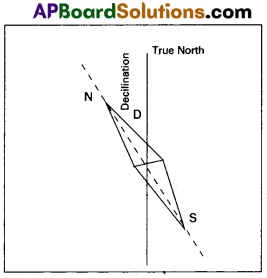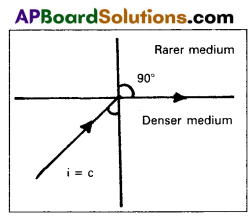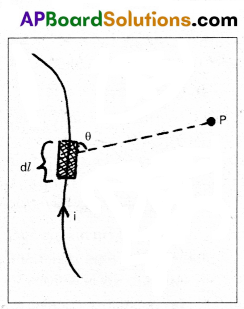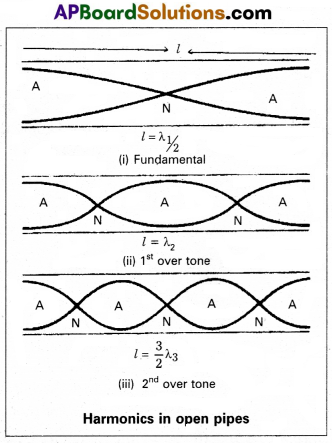Thoroughly analyzing TS Inter 2nd Year Physics Model Papers and TS Inter 2nd Year Physics Question Paper May 2017 helps students identify their strengths and weaknesses.
TS Inter 2nd Year Physics Question Paper May 2017
Time: 3 Hours
Maximum Marks: 60
Section – A (10 × 2 = 20)
Note :
- Answer all questions.
- Each question carries two marks.
- All are very short answer type questions.
Question 1.
What is myopia ? How can it be corrected ?
Answer:
Myopia (or) Near sightedness : The light from a distant object arriving at the eye-lens may get converged at a point infront of the retina. This type of defect is called myopia.
To correct this, we interpose a concave lens between the eye and the object.

Question 2.
Define magnetic declination.
Answer:
Magnetic Declination (D): The angle between the true geographic north and the north shown by a compass needle is called magnetic declination or simply declination (D).

Question 3.
What are the applications of microwaves ?
Answer:
- Microwaves are used in Radars.
- Microwaves are used for cooking purposes.
- A radar using microwave can help in detecting the speed . of automobile while in motion.
Question 4.
What is “Photoelectric effect” ?
Answer:
When light of sufficient energy is incident on the photometal surface, electrons are emitted. This phenomenon is called photoelectric effect.
![]()
Question 5.
Write down de Broglie’s relation and explain the terms there in.
Answer:
λ = \(\frac{h}{P}\)
Where λ = Wavelength
h = Plancks constant
P = Momentum of a particle
Question 6.
What is magnetic moment associated with a circular coil of ‘N’ turns having radius of cross-section ‘r’ carrying a current I ?
Answer:
Magnetic moment (M) = N i A
M = N i (πr2) (∵ A = πr2)
∴ M = π N i r2
Question 7.
In a transformer the primary to secondary turns ratio is 1 : 2. If an A.C current of 4 Ampere is flowing through the primary coil, what is the current in secondary ?
\(\frac{\mathrm{I}_2}{\mathrm{I}_1}=\frac{\mathrm{N}_2}{\mathrm{~N}_1}\) ⇒ \(\frac{\mathrm{I}_2}{4}=\frac{1}{2}\)
∴ I2 = 2A
Question 8.
In choosing materials for transformer cores, what criteria is taken for the material in the case of its material resistivity and area of hysteresis curve to decrease eddy current losses ? ‘
Answer:
The core material should have high initial permeability, low hysterisis loss and high resistivity to reduce loss of eddy currents.
Question 9.
Draw the circuit symbols for p-n-p and n-p-n transistors.
Answer:

Question 10.
Define modulation. Why is it necessary ?
Answer:
Modulation: The process of combining low frequency audio signal with high frequency carrier wave is called modulation.
The audio frequency signals canqot be transmitted over long distances faithfully. Therefore they are combined with high frequency waves and transmitted.
![]()
Section – B (6 × 4 = 24)
Note :
- Answer any six of the following questions.
- Each question carries four marks.
- All are short answer type questions.
Question 11.
Define critical angle. Explain total internal reflection using a neat diagram.
Answer:
Critical angle : When light ray travelling from denser medium to rarer medium, then the angle of incidence for which angle of refraction in air is 90° is called critical angle.
C = sin-1(\(\frac{1}{\mu}\))
Total internal reflection : When a light ray travels from denser to rarer medium,’ the angle of incidence is greater than the critical angle, then it reflects into the same medium is called total internal reflection.

Explanation : Consider an object in the denser medium. A ray OA incident on XY bends away from the normal. As the angle of incidence is increased, the angle of refraction goes pn increasing. For certain angle of incidence, the refracted ray parallel to XY surface (r = 90°).

When the angle of incidence is further increased, the ray is not refracted but is totally reflected back in the denser medium. This phenomenon is called total internal reflection.
Question 12.
State Gauss’s law in electrostatics and explain its importance.
Answer:
Gauss’s law : The total electric flux through any closed surface is equal to \(\frac{1}{\varepsilon_0}\) times the net charge enclosed by the surface.
Total electric flux, Φ = \(\oint \vec{E} \cdot d \vec{s}\) = \(\frac{\mathrm{q}}{\varepsilon_0}\)
Here q is the total charge enclosed by the surface ‘S’, \(\oint\)represents surface integral of the closed surface.
Importance :
- Gauss’s law is very useful in calculating the electric field in case of problems where it is possible to construct a closed surface. Such surface is called Gaussian surface.
- Gauss’s law is true for any closed surface, no matter what its shape or size.
- Symmetric considerations in many problems make the application of Gauss’s law much easier.
Question 13.
Describe the ways in which eddy currents are used to advantage.
Answer:
Eddy currents are used to advantage in
i) Magnetic breaking in trains : A strong magnetic field is applied across the metallic drum rotating with the axle of the electric train. Thus large eddy currents are produced in the metallic drum. These currents oppose the motion of the drum and hence the axle of the train which ultimately makes the train come to rest.
ii) Induction Motor : Eddy currents are used to rotate the short circuited rotor of an induction motor. Ceiling fans are also induction motors which run on single phase alternating current.
iii) Electromagnetic damping: Certain galvanometers have a fixed core made of non magnetic metallic material. When the coil oscillates, the eddy currents generated in the core oppose the motion and bring the coil to rest quickly.
iv) Induction furnace : Induction furnace can be used to produce high temperatures and can be utilised to prepare alloys, by melting the constituent metals. A high frequency alternating current is passed through a coil. The eddy currents generated in the metals produce high temperatures sufficient to melt it.
v) Analogue energy meters : Concept of eddy currents is used in energy meters to record the consumption of electricity. Aluminium disc used in these meters get induced due to varying magnetic field. It rotates due to eddy currents produced in it.
Question 14.
What are the limitations of Bohr’s theory of hydrogen atom ?
Answer:
Limitations of Bohr’s theory of Hydrogen atom :
- This theory is applicable only to simplest atom like hydrogen, with Z = 1. The theory fails in case of atoms of other elements for which Z > 1.
- The theory does not explain why orbits of electrons are taken as circular, while elliptical orbits are also possible.
- Bohr’s theory does not say anything about the relative . intensities of spectral lines.
- Bohr’s theory does not take into account the wave properties of electrons.
Question 15.
What is rectifier ? Explain the working of a diode as full wave rectifier with diagram.
Answer:
Rectification : The process of converting on alternating current into a direct current is called rectification.

The device used for this purpose is called rectifier.
- A full wave rectifier can be constructed with the help of two diodes D1 and D2.
- The secondary transformer is centre tapped at C and its ends are connected to the p regions of two diodes D1 & D2.
- The output voltage is measured across the load resistance RL.
- During positive half cycles of ac, the diode D1 is forward biased and current flows through the load resistance RL. At this time D2 will be reverse biased and will be in switch off position.
- During negative half cycles of ac, the diode D2 is forward biased and the current flows through RL. At this time D1 will be reverse biased and will be in switch off position.
- Hence positive output is obtained for all the input ac signals.
- The efficiency of a rectifier is defined as the ratio between the output dc power to the input ac power.
η = \(\frac{\mathrm{P}_{\mathrm{dc}}}{\mathrm{P}_{\mathrm{ac}}}=\frac{0.812 \mathrm{R}_{\mathrm{L}}}{\mathrm{r}_{\mathrm{f}}+\mathrm{R}_{\mathrm{L}}}\)
The maximum efficiency of a full wave rectifier is 81.2%.
![]()
Question 16.
State and explain Biot-Savart Law.
Answer:
Consider a very small element of length dl of a conductor carrying current (i). Magnetic induction due to small element at a point p distance r from the element.
Magnetic induction (dB) is directly proportional to i)current (i) ii) Length of the element (dl) iii) sine angle between r and d! and iv) Inversely proportional to the square of the distance from small element to point P.

Question 17.
What is Malu’s law ? Write any two applications of Polaroids.
Answer:
Malus law: “Itstates that intensity of polarised light transmitted through the analyser varies as a square of cosine of the angle between the plane of transmission of analyser and polariser”.
⇒ I ∝ cos2 θ
∴ I = I0 cos2 θ
Applications of polaroids :
- Polaroids are used in sunglasses.
- Polaroids are used to reduce head light glare of cars.
Question 18.
Three capacitors of capacitances 2 μF, 3 μF and 4 μF are, connected in parallel. What is the total capacitance of the
combination ? Determine the charge on each capacitor if the combination is connected to a 100 V supply.
Answer:
C1 = 2 μF, C2 = 3 μF, C3 = 4 μF
i) In parallel combination C = C1 + C2 + C3
C = 2 + 3 + 4
C = 9 μF
ii) V = 200V, C = 9μF
q1 = C1V = 2 × 10-6 × 200 = 4 × 10-4C
q2 = C2V = 3 × 200 × 10-6 = 6 × 10-4C
q3 = C3V = 3 × 200 × 10-6 = 8 × 10-4C
![]()
Section – C (2 × 8 = 16)
Note :
- Answer any two of the following questions.
- Each question carries eight marks.
- All are long answer type questions.
Question 19.
Explain the formation of stationary waves in an air column enclosed in open pipe. Derive the equations for the frequencies of the harmonics produced.
A pipe 30 cm long is open at both ends. Which harmonic mode of the pipe resonates a 1.1 kHz sources ? The speed of sound in air is 330 ms-1.
Answer:
A pipe, which is opened at both ends is called open pipe. When a sound wave is sent through a open pipe, which gets reflected by the earth. Then incident and reflected waves are in same frequency, travelling in the opposite directions are super – imposed stationary waves are formed.
Harmonics in open pipe : To form the stationary wave in open pipe, which has two anti nodes at two ends of the pipe with a node between them.

∴ The vibrating length (l) = half of the wavelength (\(\frac{\lambda_1}{2}\))
l = \(\frac{\lambda_1}{2}\) ⇒ λ1 = 2l
fundamental frequency v1 = \(\frac{\mathrm{v}}{\lambda_1}\) where v is velocity of sound in air
v1 = \(\frac{υ}{2 l}\) = v ………… (1)
(ii) For second harmonic (first overtone) will have one more node and antinode than the fundamental.
If λ2 is wavelength of harmonic l = \(\frac{2 \lambda_2}{2}\) ⇒ λ2 = \(\frac{2 l}{2}\)
If ‘v2‘ is frequency of second harmonic then
v2 = \(\frac{υ}{\lambda_2}\) = \(\frac{υ \times 2}{2 l}\) = 2v
v2 = 2v …………. (2)
Similarly for third harmonic (second overtone) will have three nodes and four antinodes as shown in above figure.
If v3 is wave length of third harmonic l = \(\frac{3 \lambda_3}{2}\)
λ3 = \(\frac{2 l}{3}\)
If ‘v2‘ is frequency of third harmonic then
v3 = \(\frac{v}{\lambda_3}\) = \(\frac{v \times 3}{2 l}\) = 3v
v3 = 3v …………. (3)
Similarly we can find the remaining or higher harmonic frequencies i.e v3, v4 etc., can be determined in the same way.
Therefore the ratio of the harmonic frequencies in open pipe can be written as given below.
v : v2 : v2 = 1 : 2 : 3
Problem :
Given V = 330 m/s; l = 30 cm = 30 x 10-2 m
Frequency of nth harmonic of open pipe γn = \(\frac{\mathrm{nV}}{2 \mathrm{~L}}\)
For n = 1, γ1 = \(\frac{1 \times 330}{2 \times 30 \times 10^{-2}}\) = 550HZ
For n = 2, γ2 = \(\frac{2 \times 330}{2 \times 30 \times 10^{-2}}\) = 1100 Hz = 1.1 kHz
A source of 1.1 kHz resonate at γ2 with air column in open pipe.
Question 20.
State the working principle of potentiometer and explain with the help of circuit diagram how the potentiometer is used to determine the internal resistance of the given primary cell.
Answer:
Working principle of potentiometer: The potential difference across a length of the potentiometer, wire is directly proportional to its length (or) when a steady current is passed through a uniform wire, potential drop per unit length or potential gradient is constant,
i.e. ε ∝ l ⇒ ε = Φl
where Φ is potential gradient.
Measurement of internal resistance (r) with potentiometer :
- Potentiometer to measure internal resistance (r) of a cell (ε) is shown in diagram.
- The cell (emf ε) whose internal resistance (r)is to be determined is connected across a resistance box (R.B) through a key K2.
- With key K2 open, balance is obtained at length l1 (AN1).
Then ε = Φl1 ………… (1) - When key K2 is closed, the cell sends a current (T) through the resitance box (R.B).
- If V is the terminal potential difference of the cell and , balance is obtained at length l2 (AN2).
Then V = Φ l2 …………. (2) - \(\frac{(1)}{(2)}\) ⇒ \(\frac{\varepsilon}{\mathrm{v}}=\frac{l_1}{l_2}\) ……….. (3)
- But ε = I (r + R) and V = IR. This gives s (r + R)
\(\frac{\varepsilon}{V}=\frac{(\mathrm{r}+\mathrm{R})}{\mathrm{R}}\)
\(\frac{l_1}{l_2}\) = (\(\frac{r}{R}\) + 1) [∵ from (3)]
∴ r = R (\(\frac{l_1}{l_2}\) – 1)
![]()
Question 21.
Explain the principle and working of a nuclear reactor with the help of labelled diagram.
Answer:
Principle : A nuclear reactor works on the principle of achieving controlled chain reaction in natural Uranium 238U enriched with 235U, consequently generating large amounts of heat.
A nuclear reactor consists of
(1) Fuel
(2) Moderator
(3) Control rods.
(4) Radiation shielding
(5) Coolant.

1. Fuel and clad : In reactor the nuclear fuel is fabricated in the form of thin and long cylindrical rods. These group of rods treated as a fuel assembly. These rods are surrounded by coolant, which is used to transfer of heat produced in them. A part of the. nuclear reactor which use to store the nuclear fuel is called the core of the reactor. Natural uranium, enriched uranium, plutonium and uranium – 233 are used as nuclear fuels.
2. Moderator : The average energy of neutrons released in fission process is 2 MeV. They are used to slow down the velocity of neutrons. Heavy water or graphite are used as moderating materials in reactor.
3. Control Rods : These are used to control the fission rate in reactor by absorbing the neutrons. Cadmium and boron are used as controlling the neutrons, in the form of rods.
4. Shielding : During fission reaction beta and gamma rays are emitted in addition to neutrons. Suitable shielding such as steel, lead, concrete etc are provided around the reactor to absorb and reduce the intensity of radiations to such low levels that do not harm the operating personnel.
5. Coolant: The heat’generated in fuel elements is removed by using a suitable coolant to flow around them. The coolants used are water at high pressures, molten sodium etc.
Working : Uranium fuel rods are placed in the aluminium cylinders. The graphite moderator is placed in between the fuel cylinders. To control the number of neutrons, a number of control rods of cadmium or beryllium or boron are placed in the holes of graphite block. When a few 235U nuclei undergo fission fast neutrons are liberated. These neutrons pass through the surrounding graphite moderator and loose their energy to become thermal neutrons. These thermal neutrons are captured by 235U. The heat generated here is used for heating suitable coolants which in turn heat water and produce steam. This steam is made to rotate steam turbine and there by drive a generator of production for electric power.